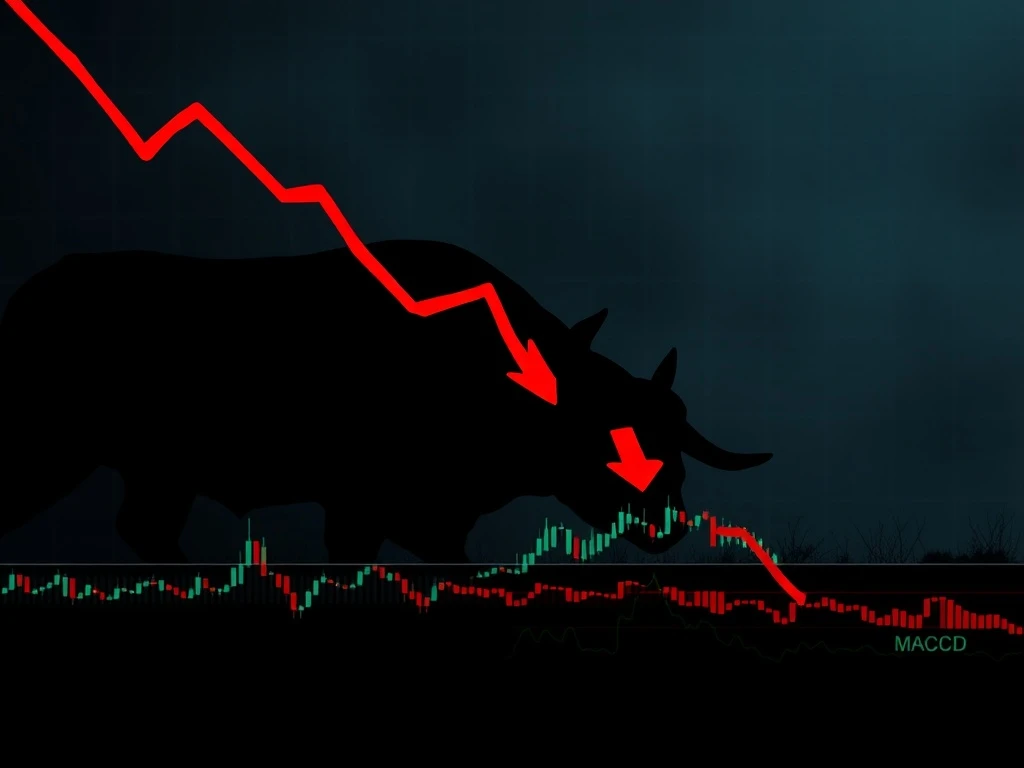Urgent Warning: Bitcoin Bull Market Faces Three Critical Bearish Signals

The cryptocurrency world is buzzing with a crucial question: Is the current Bitcoin bull market nearing its end? Recent market movements and technical indicators suggest a potential shift. While many investors hope for continued gains, some analysts are sounding the alarm. They point to several compelling reasons why the current upward trend for Bitcoin price might be over. This article delves into these bearish arguments, offering a comprehensive crypto market analysis to help you understand the potential implications for your portfolio.
Decoding Bearish Signals: The MACD Indicator and Bitcoin Price
One significant indicator raising concerns among analysts is the Moving Average Convergence Divergence (MACD). This technical tool helps traders identify trend changes and momentum shifts. According to analyst Jesse Olson, a “bearish MACD crossover” has emerged on Bitcoin’s three-week chart. This pattern often signals a potential reversal in momentum. Historically, such crossovers have coincided with major market tops.
Specifically, the MACD’s blue wave moving below its orange signal line confirms this bearish crossover. This event previously marked the peak of the 2017 and 2021 bull cycles. Therefore, its current appearance suggests a similar outcome for the ongoing Bitcoin bull market. The histogram, which measures the distance between the MACD and signal lines, also shows longer-term bearish divergence. This further reinforces the potential for a downtrend. Understanding these technical patterns is vital for any serious crypto market analysis.
Bearish Engulfing Candles and Declining Network Activity
Beyond the MACD, other chart patterns support the bearish outlook. The same three-week chart displays a “bearish engulfing candle.” This specific candle formation appeared at the peak of both the 2017 and 2021 bull cycles. Its recurrence now adds weight to the argument that the market top is in. These visual cues are critical for technical traders.
Furthermore, declining network activity provides another layer of concern. On-chain demand for Bitcoin appears to be waning. Data from Nansen reveals a significant drop in daily active addresses on the Bitcoin network. In October, this number decreased by 30%, falling from 632,915 to 447,225. A reduction in active addresses typically indicates less user engagement and lower demand. This trend often precedes price corrections or periods of prolonged consolidation. Therefore, investors should closely monitor these fundamental metrics as part of their ongoing crypto market analysis.
The Bitcoin Halving Cycle: A Historical Perspective on Bitcoin Price
The Bitcoin halving cycle is a cornerstone of market analysis. Pseudonymous trader Mister Crypto highlights that Bitcoin often peaks within a specific window after a halving event. Looking at past cycles in 2012 and 2016, price momentum typically peaks between 518 and 580 days post-halving. We are currently 558 days past the 2024 Bitcoin halving. This places the market squarely within this historical peak window. This observation leads many to question if this time will be different.
CryptoBird, another analyst, agrees that Bitcoin may have limited time for further price expansion. He suggests that if historical patterns hold, the current cycle’s “top window is open.” He notes that Bitcoin is “consolidating before an explosion,” but implies this explosion might be the final leg of the bull run. Understanding the historical context of the Bitcoin halving is crucial for anticipating future movements in the Bitcoin price. However, some argue that the impact of halvings is diminishing due to new market dynamics.
Is This Time Different? Evolving Market Dynamics and the Bitcoin Bull Market
Not all analysts agree that the bull market is over. Some believe the four-year Bitcoin halving cycle is less relevant now. Arthur Hayes of BitMEX, for instance, argues that monetary policy and liquidity are now the primary drivers of prices. He suggests these factors outweigh the halving’s influence. This perspective introduces a new layer to crypto market analysis.
Furthermore, several factors could extend the current Bitcoin bull market. These include a positive interest rate cycle and increased institutional adoption. The approval of Bitcoin ETFs and the growing number of Bitcoin treasury companies signal greater mainstream acceptance. This maturation as a mainstream asset could lead to significant upside in 2026 and beyond. Therefore, while historical patterns are important, new variables must also be considered.
Counterarguments: Why Bitcoin Price Could Still Soar
Despite the bearish warnings, many analysts maintain a bullish outlook for Bitcoin price. Analyst Jelle points out that Bitcoin has “formed a higher low and the range remains intact” on the daily time frame. He suggests that reclaiming the $116,000 region could signal a resumption of upward momentum. This indicates that the current consolidation might be a temporary pause rather than a definitive end.
Fellow analyst Mags identifies a “bullish megaphone pattern” in Bitcoin’s trading chart. Historically, such patterns have led to significant upside breakouts. He confidently states, “A massive breakout is loading.” These technical observations provide a contrasting view to the bearish indicators. They suggest that underlying strength still exists within the market. This divergence in expert opinion highlights the complexity of crypto market analysis.
The Mayer Multiple and Future Bitcoin Price Targets
Further supporting the bullish case, the Bitcoin Mayer Multiple suggests that BTC remains closer to “oversold” levels. This indicator compares the current Bitcoin price to its 200-day moving average. A low Mayer Multiple often indicates that Bitcoin is undervalued relative to its historical performance. This implies that there is still considerable room for growth. Therefore, the ambitious $180,000 target for Bitcoin price remains a possibility for some analysts.
Ultimately, the debate continues. Is the Bitcoin bull market truly over, or is this a temporary consolidation before another leg up? Investors must weigh these conflicting signals carefully. Both technical indicators and fundamental factors offer compelling arguments. Conducting thorough personal research is essential before making any investment decisions in this volatile market. The future trajectory of Bitcoin remains a topic of intense discussion and speculation among experts.
This article does not contain investment advice or recommendations. Every investment and trading move involves risk, and readers should conduct their own research when making a decision.








